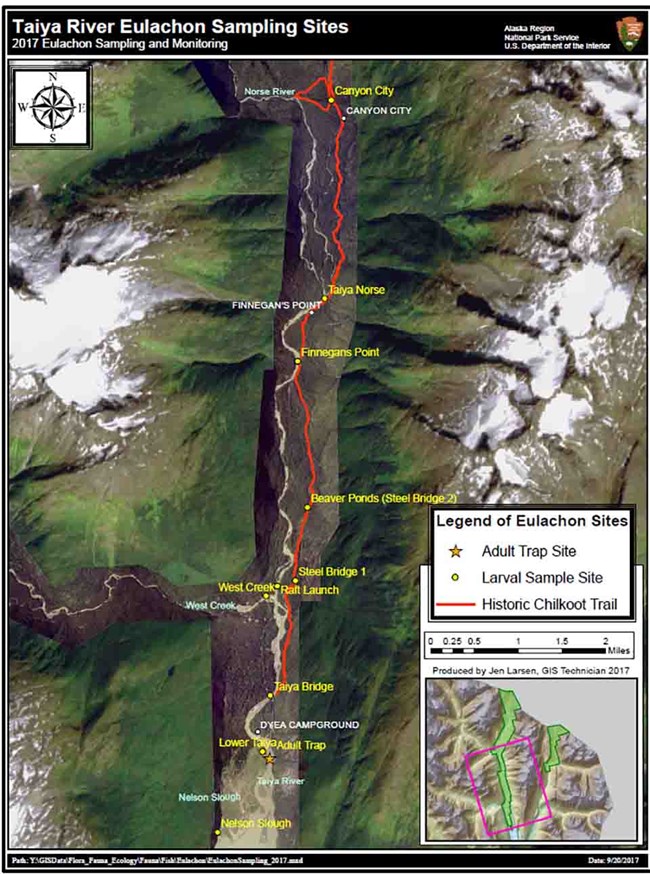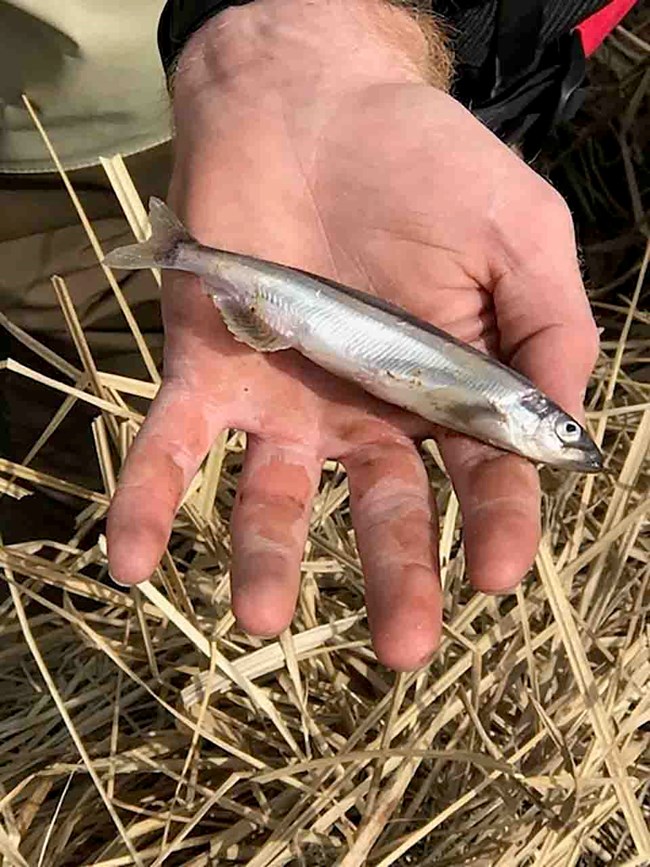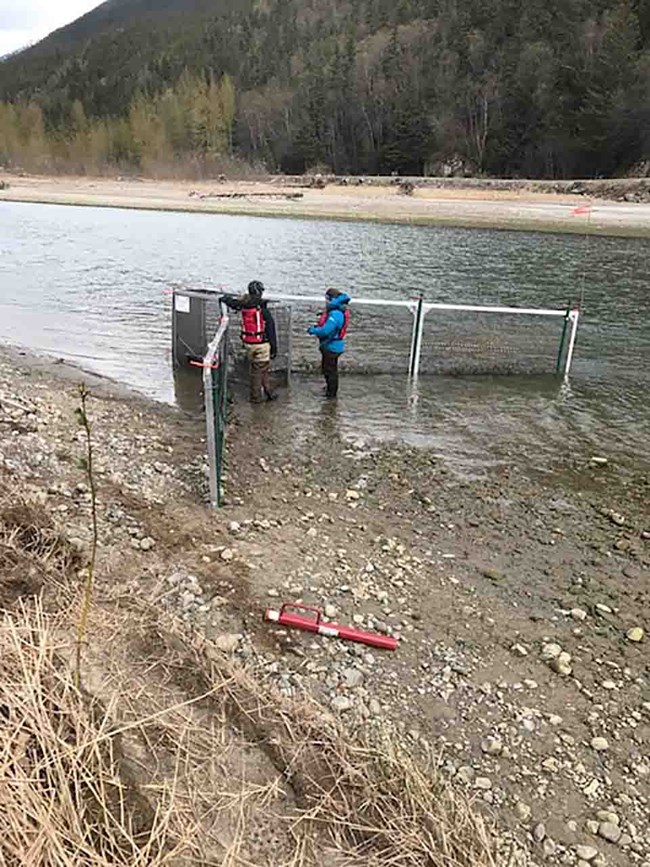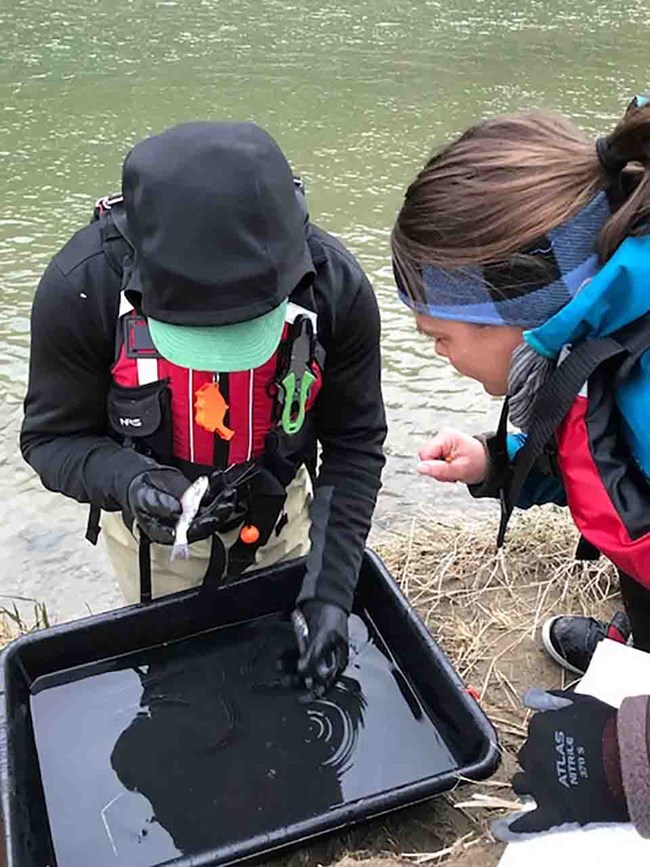Last updated: June 13, 2018
Article
Monitoring Eulachon in Klondike Gold Rush National Historical Park

1NPS Alaska Regional Office, Alaska SeaGrant; sarah_apsens@partner.nps.gov
2NPS Skagway National Historic Park; andrew_waldo@nps.gov
3NPS Skagway National Historic Park; jami_belt@nps.gov
In late April of 2017 gulls, bald eagles, and harbor seals, and a few intrepid scientists congregated near the outlet of the Taiya River. Located near Skagway Alaska, the Taiya River flows from the Coastal Mountains, through Klondike Gold Rush National Historical Park (hereafter Klondike Gold Rush), and into a large estuary delta near the former Gold Rush town of Dyea. On this mild spring day, humans and wildlife alike were eagerly awaiting the same natural phenomenon- the arrival of a small, silvery, unassuming fish known by many names.
Sometimes called hooligan or candlefish, but most often referred to as Eulachon (Figure 1), Thaleichthys pacificus, is an anadromous smelt. These fish grow and feed in the cold waters of the North Pacific before returning to rivers in late winter or early spring to reproduce. Much like salmon, Eulachon are fundamentally semelparous, or reproduce once and die shortly thereafter (Clarke et al. 2007). Iteroparous (spawn more than once) individuals exist in some populations at unknown frequencies (Willson et al. 2016). Adult Eulachon generally spawn at 2-5 years old (Willson et. al. 2006). While spawning is reported to take place at a wide range of temperatures 0oC -10oC in different river systems, with run timing occurring in earlier in warm years (Willson et al. 2006), raising concern about predicted changes in river temperatures.

Eulachon historic range stretched from northern California to Alaska, but today the southern runs are severely depleted or extinct. In 2010, the population segment of Eulachon that spawn in California, Oregon, and Washington were listed as threatened under the Endangered Species Act (NOAA 2010) and all populations that spawn south of the Nass River in northern British Columbia were listed under British Columbia’s Blue List* (*this applies to an ecological community or indigenous species and subspecies considered to be of special concern; B.C. Conservation Data Centre 2017). Changes in ocean conditions, spawning habitat, and overfishing have been linked with Eulachon population declines. For now, Alaska’s runs appear to be persistent, but very little is known about Eulachon return numbers and population trends, and many questions about their life history remain.
Eulachon are prized as a food source by both humans and wildlife throughout Southeast Alaska. Extremely high in oils; up to 20% of Eulachon body mass is fat. The oils and energy provided by this fish have been important to people in the region for generations. Anthropologists consider the eulachon a keystone species of West Coast Native culture (Senkowsky 2007). Oil rendered from the eulachon was, and still is, an important medicine, food, fuel, and trade item.
The importance of Eulachon is reflected in the history of the nearby Chilkoot Trail. During the Gold Rush era, an estimated 30,000 individuals (Karl Gurcke, pers. comm.) used the trail to cross the rugged Coast Mountains on their way to the Klondike Gold Fields. Prior to the 1890s, the Chilkoot Trail had already been used for generations. Known as “grease trails,” coastal and inland tribes in the region used trails like the famous Chilkoot Trail as trade routes to transport highly valuable rendered Eulachon oil for trade with their interior neighbors (Flannery et. al. 2009). Eulachon is still of traditional and subsistence significance in the region. Little is known about the extent of subsistence use in Skagway, but subsistence use is well documented in nearby communities of Haines and Klukwan. In 2012, 162,060 pounds of Eulachon were harvested in the two communities, with 95.5% of households using the resource according to the Alaska Department of Fish & Game Community Subsistence Information System, proving Eulachon are still an important resource for people in the area.
Eulachon are also an important food source for many species of wildlife in the North Pacific and Southeast Alaska coast. Eulachon typically arrive in early spring, a time of high energy demands for sea lions, river otters, harbor seals, and migrating shore birds (Sigler et al. 2004). Sea lions will haul out near Eulachon runs in the spring (Womble et al. 2005), ensuring availability of an energy dense food source for pregnant females and migrating males. The congregation of Eulachon in Southeast Alaskan Rivers occurs at a time of year when other prey are unavailable, making Eulachon an ecological cornerstone for coastal systems (Marston et al. 2002). Due to the cultural and environmental importance of Eulachon, it is important that we learn more about this species about which we know so little.
In spring of 2017 NPS biologists from Klondike Gold Rush National Historical Park, in partnership with the Skagway Traditional Council and Taiya Inlet Watershed Council, began a two year endeavor to learn more about this fish. While studies have been conducted in other southeast Alaskan rivers, no research had been implemented for the Taiya River. Estimates suggest that fewer than 60 rivers host anadromous eulachon runs (Willson et. al 2006), making The Taiya a critical piece of the puzzle. A pilot study in 2016 at Klondike Gold Rush helped researchers determine appropriate sampling methods. Based on the pilot study, a two stage sampling design was determined to be the best method to gather important ecological information for both adult and larval fish. For the first stage, a fish trap located in the lower Taiya River would be used to collect information on incoming adult Eulachon beginning in April 2017. The second stage would start in May, where out-drifting Eulachon larvae would be captured using fine mesh ichthyoplankton nets. Additionally we planned to collect environmental DNA (eDNA) samples to look for and amplify for traces of Eulachon DNA that naturally occur when the fish slough off cells in water samples from the Taiya River. Successful use of eDNA would allow us to detect the fish in areas where adults or larvae may evade our traps and may offer promise of a low-cost and long-term sustainable method for measuring eulachon abundance.
The adult Eulachon trap was installed in the Taiya River on April 26th, and the wait for the arrival of the fish began. The design of the Taiya River fish trap was based on a trap successfully used to catch adult Eulachon by the Chilkoot Indian Association and Takshanuk Watershed Council in the neighboring community of Haines. The fish trap included two large wings (about 16 ft long x 4 ft tall), and a holding pen (6 ft long x 2ft wide x 4 ft tall; Figure 2). The trap functioned similar to a fyke net in that the wings served to corral fish swimming upstream towards the central holding pen. Once captured, the fish were pulled from the pen using dip nets. Small doors on the holding pen were opened to allow Eulachon to escape when monitoring was not taking place.

We checked the trap on the incoming and outgoing tides day to day eagerly anticipating the arrival of fish. Multiple days passed, but the Taiya river trap remained empty. Rumors circulated that Eulachon had arrived in Haines a few days earlier. Sea Lions, which are known to arrive with the Eulachon, had been spotted from Yukutania Point headed towards the mouth of the Taiya River. The small silvery fish finally appeared on May 2nd. Accompanying the arrival of Eulachon was a surge in wildlife at the mouth of the Taiya. At the height of the run, thousands of gulls flew overhead of the trap, diving to pluck fish from the water. Harbor seals swam like torpedoes through the water chasing fish. Eagles perched along the shore observed the chaos. Seals would occasionally pop their heads out of the water to inspect us going about our work.
We counted and identified the sex of 171 Eulachon. Captured fish were held in water filled bins to minimize stress from processing (Figure 3). Fish were measured for length (mm) and weight (g). We released the majority of fish collected. Captured Eulachon had an average weight of 32.3g (Stdev ± 7.44) and an average length of 170.5mm (Stdev ± 12.45). The adult Eulachon run was 20.5% female and 79.5% male, or 3.9:1 ratio of males to females. Similar sex ratios have been observed elsewhere, but these finding raise questions about whether our sampling technique may be missing females because of their tendency to enter the river in separate waves and retreat to the bay in the daytime (Willson et al. 2006). Eighteen females were retained to be dissected to determine relative fecundity (how many eggs each female carried). On average females carried 16,912 eggs each (Stdev ± 5,337). During adult trapping, environmental parameters such as water temperature, tide state and height, wind speed, and river discharges were recorded. We determined the adult Eulachon run to be over on June 8th, when no pre-spawn adults had been captured for more than a week.

The second stage of the project focused on egg and larval out drift. Shortly after spawning occurs, eggs drift downstream until they stick to sand or gravel substrate. Depending on water, temperature the eggs will then incubate for 20-40 days before the larvae hatch. Colder water temperatures generally lead to longer incubation times. Upon hatching larvae will drift out into the estuary where they will continue to grow. Plankton nets were used to intercept out-drifting eggs and larval Eulachon. Sampling began on May 23rd, 3 weeks after the first adult Eulachon was detected. Out-drifting Eulachon larvae and eggs were captured using fine mesh ichthyoplankton nets called bongo nets. Nets were towed in the Taiya River near its mouth three days a week. Distribution sampling was completed once a week at ten sites from the Taiya Bridge up to Canyon City, in West Creek, and Nelson Slough. Environmental parameters including water and air temperature, tide state and high, wind speed and direction, cloud cover, precipitation, river depth, and river discharge were noted. This type of sampling allows biologists to determine where and how far up river and where fish are spawning in the Taiya watershed. Ichthyoplankton sampling ended 10 weeks after the first adult Eulachon was detected, or approximately 7 weeks after the last adult was detected.
Samples collected using the nets were stored in jars and the larval Eulachon and eggs in each sample were counted and tallied. A total of 83 Eulachon larvae/eggs were caught in the Taiya River. The furthest upstream larvae/ eggs were located at the bridge just south of the Beaver ponds, approximately 5 river miles from the estuary and well above tidal influence. This finding is intriguing because in many rivers, the spawning reach is limited to the tidally influenced areas of the river (Lewis et al. 2002). We did not catch any Eulachon larvae/eggs in West Creek but we did catch 3 Eulachon larvae in Nelson Slough.
We also collected river water samples each time we completed adult and larval sampling to look for eDNA. Use of eDNA in sampling for presence or absence of a species in the environment is a proven technique. Our goal was to use eDNA to determine where Eulachon were present throughout the Taiya River’s reaches and to provide a backup method for letting us know whether the adult or larval fish were slipping by our traps undetected. A secondary goal was to determine whether eDNA could be used to measure abundance or as an index of run strength. It is not currently well known if eDNA can be used to accurately determine fish population and run sizes in aquatic environments, but many pioneering studies are underway to test this potential (Lodge et al. 2012). Preliminary studies underway by our collaborators at Chilkoot Indian Association and Takshanuk Watershed Council have shown that the peak of eDNA concentrations in water samples were strongly correlated with peaks in abundance found using adult capture methods (M. Pochardt, pers. comm.). Our study offers another opportunity to forge ahead with testing eDNA as a method for measuring population status, as it provides a three way comparison between abundance estimates made using eDNA, adult sampling and larval sampling. At this time, eDNA results are still being analyzed.
With repeated sampling over the next few years researchers will be able to learn a great deal about Eulachon population trends in the Taiya River and other rivers in Southeast Alaska. The number of eggs and larvae per net, combined with river discharge, average number of eggs per female, and adult sex ratio, allows biologists to estimate the total number of fish that returned to the Taiya River each year. In addition, we will be able to develop and index of Eulachon run strength that will be essential for long-term monitoring of this resource. Continued monitoring of spawning Eulachon will be increasingly important as environmental conditions change. Similar to other high latitude seas, the Gulf of Alaska is expected to become warmer and acidic in the future (Fabry et al. 2009). Ocean acidification may impact the invertebrate prey species Eulachon feed on in marine habitats. Predicted increases in stream water temperature may alter timing of spawning and duration of egg incubation, similar to what is predicted for salmonids in Southeast Alaska (Bryant 2009). The horizon for Eulachon is uncertain and it is critical that we learn what we can about the species before changes occur.
To learn more about this project visit https://www.nps.gov/klgo/learn/nature/eulachon.htm where you will find a short video about the Eulachon monitoring project in Klondike Gold Rush National Historical Park.
References
B.C. Conservation Data Centre. 2017. BC Species and Ecosystems Explorer. B.C. Minist. of Environ. Victoria, B.C. Available: http://a100.gov.bc.ca/pub/eswp/ (accessed Dec 12, 2017).
Bryant, M.D. (2009). Global climate change and potential effects on Pacific salmonids in freshwater ecosystems of southeast Alaska. Climatic Change 95: 169-193.
Clarke, A.D., A. Lewis, K.H. Telmer, J.M. Shrimpton. (2007). Life history and age at maturity of an anadromous smelt, the eulachon Thaleichthys pacificus (Richardson). Journal of Fish Biology 71: 1479-1493.
Fabry, V.J., J. B. McClintock, J.T. Mathis, J.M. Grebmeier. (2009). Ocean acidification at high latitudes: the bellwether. Oceanography 22(4): 160-171.
Flannery, B. G., J. K. Wenburg, C. J. Lewis, B. L. Norcross, and R. E. Spangler. (2009). Genetic Population Structure of Alaska Eulachon. U.S. Fish and Wildlife Service
Lewis, A. F. J., McGurk, M. D., and Galesloot, M. G. (2002). Alcan’s Kemano River eulachon (Thaleichthys pacificus) monitoring program 1988-1998. Consultant’s report prepared by Ecofish Research Ltd. for Alcan Primary Metal Ltd., Kitimat, B.C. 136 p.
Lodge, David M., et al. (2012). Conservation in a cup of water: estimating biodiversity and population abundance from environmental DNA. Molecular Ecology 21.11 (2012): 2555-2558.
Marston, B.H., M.F. Willson, S.M. Gende. (2002). Predator aggregations during eulachon Thaleichthys pacificus spawning runs. Marine Ecology Progress Series 231: 229-236.
NOAA (2010). Endangered and threatened wildlife and plants: threatened status for southern distinct population segment of Eulachon. Federal Register. Vol. 75, No. 52.
Senkowsky, S. (2007). A Feast to Commemorate—and Mourn—the Eulachon. BioScience. 57 (8):720
Sigler, M.F., J.M. Womble, and J. Vollenweider. (2004). Availability to Stellar sea lions (Eumetopias jubatus) of a seasonal prey resource: a pre-spawning aggregation of eulachon (Thaleichthys pacificus). Canadian Journal of Aquatic Science 61:1475-1484.
Wilson, M.F., R.H. Armstrong, M.C. Hermans, and K.Koshki. (2006). Eulachon: A Review of Biology and an Annotated Bibliography. Alaska Fisheries Science Center, Processed Report 2006-12.
Womble, J.N., M.F. Willson, M.F. Sigler, B.P. Kelly, G.R. VanBlaricom. (2005). Distribution of Stellar sea lions Eumetopias jubatus in relation to spring-spawning fish in SE Alaska. Marine Ecology Progress Series 294: 271-282.
